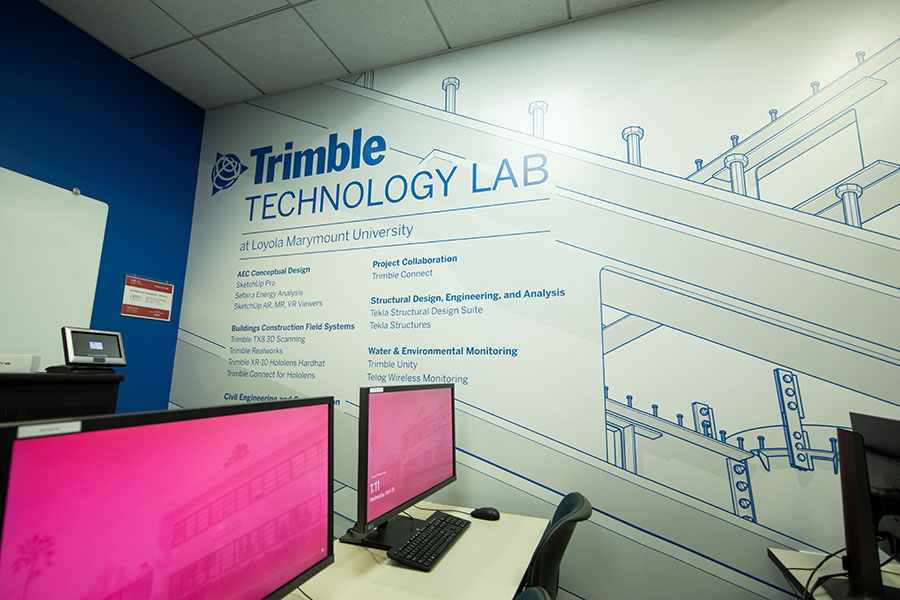
For civil engineers embarking on any new development or redevelopment project, one of the first and most essential activities involves surveying the site. Whether it’s drawing boundaries, mapping utilities, collecting environmental data or identifying potential roadblocks, surveyors establish the parameters upon which the designs are based.
Now, thanks to the support of one of the world’s leading industrial technology companies, civil and environmental engineering students at Loyola Marymount University (LMU) can conduct their surveys, environmental research and create 3D designs using some of the most innovative tools in in the industry.
The LMU Frank R. Seaver College of Science and Engineering’s newly established Trimble Technology Lab features advanced 3D data collection, design and software tools with applications across the gamut of engineering and computer science disciplines. It includes Trimble’s SketchUp and Tekla 3D design software, a Trimble XR10 augmented reality headset, and equipment such as the Trimble SX10 Scanning Total Station, which combines surveying, imaging, and high-speed 3D scanning capabilities in a single instrument — a boon for both accuracy and efficiency. “The Trimble equipment and software we now have are state of the art,” says Michael Manoogian, professor of civil and environmental engineering, who spearheaded the effort to integrate the new technology into the civil engineering curriculum. “It’s providing our students with an advanced picture of what’s possible in this field.”
With the lab’s opening, LMU joins a select group of 25 Trimble Technology Labs at universities across 14 countries on five continents. Trimble has been at the forefront of innovation since its inception in 1978 — initially as a GPS pioneer, and more recently in bringing advanced technology solutions and software to global problems in construction, agriculture, and transportation.
“Fundamentally, we’re in business to deliver technology that transforms the way the work works, and help address some difficult global sustainability challenges. And you can’t do that without top scientists, technologists, engineers, and mathematicians,” says Chris Stern ’93, Trimble’s vice president and managing director for corporate venture capital and industry partnerships, and member of the Trimble Foundation Fund board of directors. “Given how rapidly technologies continue to advance, we want to empower LMU with the tools to best prepare the future generations of engineers and scientists.
Stern, who was instrumental in the establishment of the new lab and also serves as a member of LMU’s Board of Regents and chair of Seaver’s Executive Advisory Board, has a long history of supporting LMU, its students, and the Department of Civil and Environmental Engineering. Himself a graduate of the civil engineering program — where his professors included both Manoogian and current Department Chair Don Kendall — Stern started Spacient Technologies in 2000, which provided software to the mobile utilities workforce, after consulting with Kendall, whom Stern continues to consider a mentor. Six years later, Trimble acquired Spacient and Stern became an executive at the now multibillion-dollar tech firm. From there, he began facilitating equipment and software donations for LMU programs in environmental research and surveying, as well as for the campus chapter of Engineers Without Borders.
As Trimble’s educational portfolio matured with the establishment of Trimble Technology Labs and other programs in K-12 and higher education, Stern and a group of Seaver faculty led by Kendall started engaging in conversations about taking the LMU’s technologies to the next level. “Chris began informing us about what was out there and offered an opportunity to gain access to some of the latest equipment and data-gathering techniques,” Kendall says. “That support has been invaluable, and our students are really seeing the benefits.” The equipment and software have already transformed two courses in the department, Kendall notes — a required class in surveying and mapping, which includes environmental science as well as civil engineering students; and a spatial and data geographic information system elective.
Allyson McDuffie, Trimble’s director of education and outreach, notes that the process of becoming a Trimble Technology Lab is highly vetted, with far more requests than the company is able to accommodate. “We often hear from university educators that it’s difficult to keep up with the tools industry is creating, and this program is designed to close that gap,” she says. “It’s exciting to get the latest technology into their hands so they can give their students a leg up as they enter the workforce.”
The Trimble Technology Lab exemplifies the Civil and Environmental Engineering Department’s close relationship with its professional alumni. The Civil Engineering Council for Industry Partnerships helps to keep the department’s faculty abreast of the latest developments in the field, as well as connecting students with professionals for mentoring opportunities.
For industry leaders like Stern, the relationship is about giving back. “When I was an LMU student, I was given the chance to work with new technology because of a research grant, and that, along with the support of the faculty, made a huge impact,” he says. “There are many students that can benefit from that same opportunity, and I want to help LMU — a great university founded on the principles of purpose and ethics — further its leadership role in educating and creating the next generation of science and engineering professionals.”



